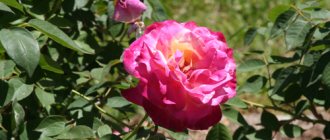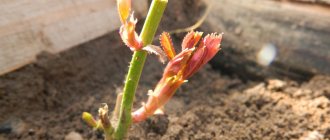Rootstock for standard rose
Rosehip is used as a rootstock for rose trees because it is well adapted to severe frosts. Branches of roses of different varieties are grafted onto its trunk. Their choice depends on the height of the desired standard rose and the shape of the future tree.
Before purchasing a standard rose, it would not hurt to ask the seller what rootstock it is grafted onto. Rose rubiginosa and rose cinnamon are not suitable for these purposes. They produce a lot of growth, the shoots are strewn with sharp thorns, and the growth of the lashes leaves much to be desired.
The trunk of low pink trees will be no more than forty-five centimeters. The height of semi-standard ones ranges from seventy to eighty centimeters.
Standard ones - up to one meter, and weeping types (they are also called cascade) - from a meter to a meter of seventy centimeters. Accordingly, small roses are usually grafted onto low trunks, and larger ones onto tall ones, which looks much more impressive.
There is also an indoor rose tree. But this is an option for an apartment; an elegant rose requires special care. It does not tolerate cold weather and severe frosts. At the first frost the flower will die. Do not confuse indoor rose with hibiscus. Very often it is called an indoor rose. Hibiscus reaches a height of 2 meters and takes up a lot of space, unlike a real miniature indoor rose.
Standard rose: photo, description of varieties
There are certain varieties of roses that gardeners most often choose for grafting into trunks. For “trees”, Grouse and Nozomi are suitable. For those that are weeping, that is, cascading, Ballerina and Canary Bird are good choices.
It is not so easy to choose suitable varieties for small standard trees. If the crown of the rose tree is thickened, it will give the impression of heaviness. And this will not at all decorate the originally intended miracle.
Low trunks are suitable for a small garden or courtyard, and one of the best varieties for them is Knirps. This rose has delicate, pink buds that look elegant on the “leg” of the trunk. Such a rose-tree will look great in the center of a flower garden, in a single copy. It does not need to be supplemented with other colors.
The Immensee variety looks very unusual, like a large but light blooming bouquet. The rose's petals seem to glow, reminiscent of the mother-of-pearl shine of pearl shells.
The variety Catherine Deneuve is also popular and widespread. It has light orange buds. The shape resembles small suns that illuminate the garden and delight the eye, lifting your spirits.
Recommended rose varieties
- Princesse de Monaco - cream petals with pink tints.
- Jardins de Bagatelle (Jardin de Bagatelle) - she has pure cream flowers.
- Scarlet Beauty - Marcel Pagnol (Marcel Pagnol).
- Catherine Deneuve, light orange flowers. A beautifully shaped rose tree will fit harmoniously into any garden.
Roses with large inflorescences are suitable for large garden plots. These include New Down. This type of rose tree is popular among gardeners. Planted as a single plant or surrounded by other flowers.
The tree rose of this variety looks great in any case. Its foliage is small, but its mass is large, so the bush looks massive. Against this green background, large light rose buds “shimmer” like stars in the sky.
Growing problems, diseases and pests
In the process of growing a standard rose tree, it is important to notice rosehip shoots in time and remove them without delay. Otherwise, a more powerful bush will simply destroy the delicate grafted flower, drowning it out.
Basically, the immunity of such plants is quite high, since the immunity of the mother plant is able to endure any troubles on its own, despite the difficulties. But it is worth looking at the characteristics of the grafted variety and its possible diseases. When they are first detected, immediate treatment is required.
How to deal with them
It is easiest to combat diseases and pests in the initial stages. Diseases most often occur due to improper care, and pests can be transferred from neighboring plants. Therefore, it is important to monitor the entire flower garden.
Important! For many diseases, damaged areas need to be removed.
Pests can be controlled in two ways: mechanically and with the help of chemicals. The first method is suitable for caterpillars, large beetles that are collected and destroyed. The second is for more dangerous parasites that suck the cell sap from the flower, while remaining almost invisible. It’s good that to help flower growers a huge number of insecticides have now been created that can cope with any problems.
Note! A tree-shaped rose can be grown not only in the garden, but also at home. The indoor version will look no worse and will decorate the room from the inside. To create it, they use homemade varieties of roses and place a support on them, regularly shaping the shape using pruning. There are fewer problems with roses growing in a room than with their garden relatives.
Growing a tall pink tree on your property is a real achievement for a gardener that you can be proud of. Especially if this is the owner of a personal plot in the central part of the country. But in the south and in European countries, thanks to the milder and warmer climate, there are simply amazing examples that are worthy of admiration and evoke dreams of doing the same on your own site. The most important thing is that now dreams become reality. You just need to put in a little effort.
Cascade rose
For cascading boles, completely different varieties of roses are selected. Paul Noel has lush pink inflorescences and an attractive aroma that can be felt from a distance. Rosarium Vetersen is a variety that is also suitable for this type of trunk; the flowers are bright pink, with a hint of fuchsia, and looks good next to hedges that are neatly trimmed.
If you prefer roses in white shades, pure as pearls, pay attention to the Alba Meidiland variety or Schneewittchen. The second variety has a more delicate and soft color, but it will delight you with flowering shoots longer.
Among the bright colors, we can suggest Leverkusen, which blooms with bright yellow flowers. From the cascade family there is also a classic of scarlet colors - Scarlett Mailandecor. All these varieties, regardless of the color of the rose petals, resemble hanging bright carpets of blooming greenery or fabulous waterfalls. Varieties, of course, play a big role when the future owner chooses such a miracle, but you also need to know how to care for them.
And 3 more climbing yellow roses
Dreaming Spiers
Dreaming Spiers
Climbing large-flowered rose with a single flowering. The flowers are 7.5 cm in diameter, double, bright yellow, collected in inflorescences. The aroma is pleasant, more noticeable in sunny weather. Sometimes it blooms again. The bush is neat, 250-350 cm high, 120-200 cm wide. Suitable for partial shade.
Easlea's Golden Rambler
Easlea's Golden Rambler
In the middle zone it grows like a rambler, although the variety itself belongs to the vikhurana hybrids. The flowers are lemon-yellow with an orange tint and a crimson coating on the outer petals, 7-9 cm in diameter, with a bright tea aroma. Flowering is very abundant, once on the shoots of the second year. The rose is powerful, the shoots are very strong, up to 3 m high.
Phyllis Bide
Phyllis Bide
Climbing polyanthus rose, easily grows up to 2.5-3 m. The flower cysts are long, the flowers are double and very beautiful, small (3 cm), the blooms are lush. The shoots are flexible, the rose is disease resistant.
Caring for standard roses
Caring for rose trees is not very different from caring for bush roses, however, there are some nuances that depend on the type of stem. Flowers require regular watering, weeding must be done frequently, the soil must be loosened for the rose to grow, it must be fertilized, protected from pests, and protected from the cold in winter.
After planting, the crown of the rose tree should be protected from drying out while the tree takes root. To do this, cover it with damp moss or cotton wool, covering it with paper on top. This “compress” must be moistened regularly, and can be removed after seven to ten days. It is better to do this in cloudy weather or in the evening.
Feeding with fertilizers
Fertilizers should be added to the soil at the time of planting the rose tree. If you want your trunk to bloom long and often, we recommend adding granulated superphosphate to the bottom of the dug planting hole.
It is advisable to carry out other fertilizing with special fertilizers for roses in the spring, until the leaves on the branches bloom. And at the end of summer, you must not forget to fertilize the soil of the rose tree with potassium, it will help the plant prepare for the winter cold.
How to plant yellow climbing roses
If you received climbing yellow roses in a colored box without shoots, then the planting process is no different from planting roses with ACS. A bare-root plant is still dormant, so you'll first need to soak the roots overnight in a bucket of water to help wake it up. We have a great detailed article on planting bare root roses >>>>.
You should also have a bag of compost on hand when you are ready to start planting your yellow climbing roses. After you dig the hole, mix some compost into the soil at a ratio of 2 parts soil to 1 part compost. This is a great seasoning for any soil and will give your climbing roses a real boost of energy!
For container roses, planting is not a problem, so you'll need to dig a hole about twice the diameter of the container they were in and the same depth. Since your yellow climbing roses are already rooted in containers, you will need to maintain the same depth when planting as in containers. For information on how to plant roses with ZKS, see our detailed material here >>>.
Mulching helps retain soil moisture
How to cover a standard tree for the winter
There are two ways to cover standard roses during cold weather.
The first is that the standard is carefully bent to the ground using pins or cross-shaped wooden rods. Then you need to throw a little earth on top in a mound.
The second is used if the standard does not bend. Then the rose tree is covered in a standing position. First, the crown is covered with some dry material, for example, hay. And they tie it with burlap on top. This option of covering roses for the winter is only possible where there is no severe frost. Otherwise, the rosewood is dug up for the winter and stored in the basement.
Main trick: how to grow a climbing rose from a bush
If with red and white varieties of climbing roses everything is more or less smooth, you can choose once-blooming varieties and large-flowered ones, which are capable of giving a second wave of flowering, then with yellow and orange roses there is a serious shortage. BUT! You can get a climbing rose from a bush rose! This trick is well known to fans of the English David Austin varieties and some Cordes hybrids. When placed skillfully, bush roses grow up to 3 meters and perfectly entwine obelisks and low arches. Such roses need support, annual sanitary pruning, winter shelter and complex feeding.
For the winter, climbing roses are removed from their support and covered
Trimming
To ensure that the rose tree looks well-groomed and has a rounded shape, it is pruned from time to time. In the first year after planting the tree, the crown branches are cut short, leaving no more than 15 centimeters from the base.
In subsequent years, pruning should be carried out depending on the condition of the tree. Those shoots that have begun to grow inside the crown should be removed; the crown of the rose should not be allowed to become too thick. It often happens that growth appears at the roots and on the trunk itself, which should also be removed.
Preparing the site for planting and rules for planting seedlings.
The optimal time for planting seedlings is considered to be from April to May. The earth should already be warmed up to 15C. It must be taken into account that sudden temperature changes are dangerous for planting material. When choosing a place to plant a seedling, you need to understand that the tree rose does not like direct sunlight, but completely dark areas are also not suitable for it. It is important to note that delicate plants do not tolerate dampness and drafts. Also, you should not plant a rose on the north side of the site. If there is no suitable place to plant the plant, then it is quite possible to plant the rose in a pot. Loamy soil is best suited for standard roses. It is diluted with river sand to make it loose and peat and compost are added for better nutrition. If the soil is highly acidic, then phosphorus flour is added to it. The seedling also needs to be prepared for planting. The root system is soaked in water. The crown is pruned depending on the variety, but, as a rule, three to five large branches are left, which should have 2-3 buds on different sides. Damaged shoots and roots are removed. Roots that are too long must be shortened to 20 centimeters. The seedling is planted in a hole 50-60 cm deep and 70 by 70 cm in size. A support must be hammered into the hole, the height of which should be less than the height of the seedling. The bottom of the pit must first be loosened and covered with expanded clay. A 5 cm mound of a mixture of peat, rotted leaves and turf, river sand and clay is poured onto the expanded clay. The composition of the mixture is adjusted depending on the planting soil. The seedling is carefully placed in the center of the hole, covered with substrate and watered. It is necessary to pay attention that the cutting is deepened no more than 5 cm. Loosening is not required. The cutting is tied with a soft ribbon to the support. For the first time, the seedling is wrapped in film. The film is removed when the seedling has already taken root. And they do it gradually.
For a stronger tree, the support must be replaced with a stronger one. It must be placed 10 cm from the rose. If you mean planting not one tree, but several, then it should be taken into account that the distance between the cuttings should be at least a meter. If you plan to plant large plants, then the distance between them must be greater.











